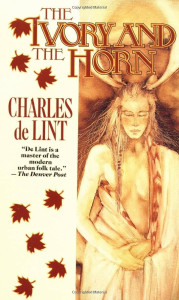 Imagine a Charles de Lint short story collection as the literary equivalent of a box of Godiva chocolates. Each individual tidbit is luscious, rich, and sensuously delicious. Unfortunately, if you eat the whole box at once, those qualities tend to get lost in a blur of overwhelming chocolatosity.
Imagine a Charles de Lint short story collection as the literary equivalent of a box of Godiva chocolates. Each individual tidbit is luscious, rich, and sensuously delicious. Unfortunately, if you eat the whole box at once, those qualities tend to get lost in a blur of overwhelming chocolatosity.
So it is with The Ivory and the Horn, a collection of individual masterpieces that lose their luster only when compared too closely with one another. Each of the stories within, with very few exceptions, shines. The only problem comes if one chooses to read all of them back to back to back, at which point each tale’s individual charms get lost in the confusion of juxtaposition.
But enough quibbling over the shades of the colors of sunset. Charles de Lint remains, as always, a master of prose. He sketches scenes simply but clearly, and gives the reader enough brushstrokes of detail to allow them to form an attachment to every house and streetcorner in his fictional city of Newford. Much as the characters in the story “Mr. Truepenny’s Book Emporium and Gallery” find themselves drawn into the reality of a fiction that they want to believe in, readers of de Lint’s stories find themselves drawn into the city he’s sketched for us. The characters of the stories presented here are the usual de Lint hodgepodge of race, gender, preference and species — ghosts and other critters share space with bike messengers, editors, social workers and the like, more or less easily. That’s one of the beauties of de Lint’s world; everyone belongs in it, and sooner or later, all of his characters accept all of his other characters’ right to exist. Not only does that spare the reader the interminable scenes of “oh no, there can’t possibly be ghosts/vampires/faeries/green men from the planet Elfpants in my safe little world” protestation that clutter up so many other modern fantasies. Charles de Lint allows his characters to believe, or at least to avoid disbelief, and the result is a world that is more subtly magical, and more welcoming to character and reader alike.
So is The Ivory and The Horn recommended? Indubitably. Don’t try to read it at one sitting; just take and savor a story here and a story there. “The Bone Woman” and “Dead Man’s Shoes” are probably the strongest stories in the collection; each is nicely chilling, yet manages to uplift the reader by the end. Still, there are no weak stories in the collection, and few that are less than excellent. Just take your time reading them, so that each can be appreciated to best effect. Otherwise, you shortchange Newford and yourself.
(Tor Books, 1996)
